The MRI-Guided Cardiac Ablation Market is estimated to be valued at USD 1.4 billion in 2025 and is projected to reach USD 3.1 billion by 2035, registering a compound annual growth rate (CAGR) of 8.1% over the forecast period.
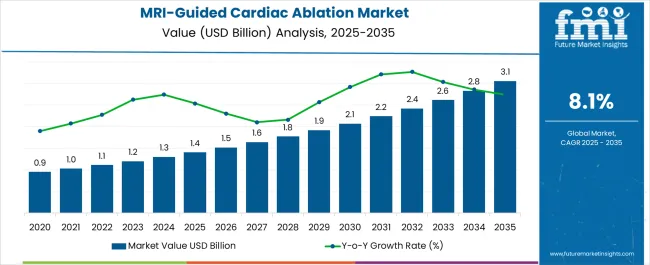
| Metric | Value |
|---|---|
| MRI-Guided Cardiac Ablation Market Estimated Value in (2025 E) | USD 1.4 billion |
| MRI-Guided Cardiac Ablation Market Forecast Value in (2035F) | USD 3.1 billion |
| Forecast CAGR (2025 to 2035) | 8.1% |
The MRI-Guided Cardiac Ablation market is experiencing strong growth, driven by the rising prevalence of cardiac arrhythmias and the increasing demand for minimally invasive treatment options. The adoption of MRI-guided procedures is supported by the ability to precisely target arrhythmic tissue while minimizing damage to surrounding cardiac structures, improving patient outcomes and reducing recovery times. Advancements in imaging technologies, catheter design, and real-time procedural guidance are enhancing treatment accuracy and safety.
Hospitals and cardiac care centers are increasingly integrating MRI-guided ablation into their interventional cardiology workflows to provide advanced patient care. Regulatory approvals and clinical studies demonstrating safety and efficacy are further boosting confidence in adoption.
The growing emphasis on personalized treatment planning, coupled with the need for improved procedural efficiency, is driving the uptake of MRI-guided ablation solutions With increasing awareness of cardiovascular health and technological advancements in catheter-based interventions, the market is expected to sustain growth over the next decade, supported by investments in healthcare infrastructure and cardiac research initiatives.
The mri-guided cardiac ablation market is segmented by product, end user, and geographic regions. By product, mri-guided cardiac ablation market is divided into MR Ablation Catheter, Stimulator System, and Others. In terms of end user, mri-guided cardiac ablation market is classified into Hospitals and Specialty Clinics. Regionally, the mri-guided cardiac ablation industry is classified into North America, Latin America, Western Europe, Eastern Europe, Balkan & Baltic Countries, Russia & Belarus, Central Asia, East Asia, South Asia & Pacific, and the Middle East & Africa.
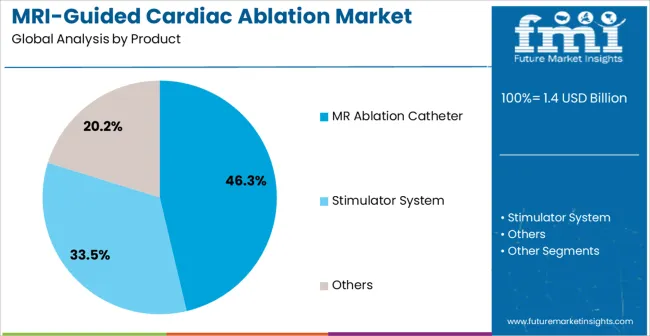
The MR ablation catheter segment is projected to hold 46.3% of the market revenue in 2025, establishing it as the leading product type. Growth in this segment is being driven by the precision, reliability, and safety offered by MR-compatible catheters during cardiac ablation procedures. The ability to provide real-time visualization of cardiac tissue and ablation sites enhances procedural accuracy and reduces the risk of complications, which has strengthened clinical adoption.
Advances in catheter design, including flexible tip navigation and integrated imaging markers, allow clinicians to target arrhythmic regions effectively. The compatibility of these catheters with MRI systems supports minimally invasive procedures and reduces radiation exposure compared to traditional fluoroscopy-guided ablations.
As hospitals and specialized cardiac centers increasingly prioritize patient safety, procedural efficiency, and treatment outcomes, MR ablation catheters are expected to maintain their market leadership The combination of clinical effectiveness, technological innovation, and procedural reliability is supporting their dominant share in the market.
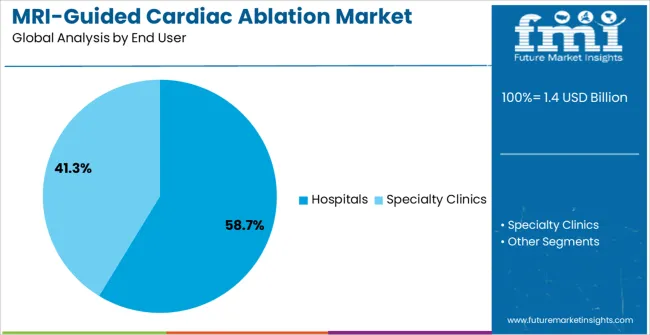
The hospitals end user segment is expected to account for 58.7% of the market revenue in 2025, establishing it as the leading end-user category. Growth in this segment is being driven by the increasing demand for advanced cardiac care services and minimally invasive treatment options within hospital settings. Hospitals benefit from centralized access to MRI systems, integrated imaging suites, and specialized cardiac care teams, which enable high-quality ablation procedures with improved patient outcomes.
The adoption of MRI-guided ablation in hospitals is supported by investments in interventional cardiology infrastructure and training programs for clinicians. Additionally, hospitals are leveraging these procedures to reduce procedural risks, shorten patient recovery times, and enhance overall operational efficiency.
Regulatory compliance, accreditation standards, and patient safety requirements further reinforce the preference for hospital-based adoption As cardiac disease prevalence rises and hospitals continue to invest in advanced imaging and treatment technologies, the hospitals segment is expected to remain the primary driver of market growth, supported by technological innovation and the demand for precision cardiac interventions.
The MRI-guided cardiac ablation procedure is a non-invasive method for treatment and diagnosis of MR based EP. The MRI guided cardiac procedure done by uses MRI compatible Catheter, stimulator and other. Compared to the conventional cardiac catheter used in imaging and mapping.
MRI guided cardiac catheter provides better soft tissue characterization and spatial resolution. The better imaging could enhance the anatomic structure of interest including neighboring structure such as the esophagus and pericardial space.
The major benefits of MRI guided cardiac ablation are the accuracy of treatment, better catheter positioning during mapping and therapy and avoid ionizing radiation and iodinated contrast agent form x-ray.The rise in demand reported for MRI-guided cardiac ablation procedure across the world. Moreover, promising growth registered by the developed market.
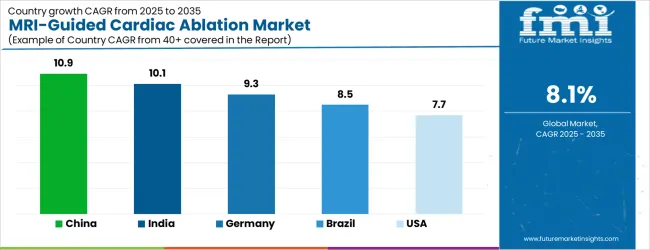
| Country | CAGR |
|---|---|
| China | 10.9% |
| India | 10.1% |
| Germany | 9.3% |
| Brazil | 8.5% |
| USA | 7.7% |
| UK | 6.9% |
| Japan | 6.1% |
The MRI-Guided Cardiac Ablation Market is expected to register a CAGR of 8.1% during the forecast period, exhibiting varied country level momentum. China leads with the highest CAGR of 10.9%, followed by India at 10.1%. Developed markets such as Germany, France, and the UK continue to expand steadily, while the USA is likely to grow at consistent rates. Japan posts the lowest CAGR at 6.1%, yet still underscores a broadly positive trajectory for the global MRI-Guided Cardiac Ablation Market.
In 2024, Germany held a dominant revenue in the Western Europe market and is expected to grow with a CAGR of 9.3%. The USA MRI-Guided Cardiac Ablation Market is estimated to be valued at USD 490.4 million in 2025 and is anticipated to reach a valuation of USD 490.4 million by 2035. Sales are projected to rise at a CAGR of 0.0% over the forecast period between 2025 and 2035. While Japan and South Korea markets are estimated to be valued at USD 65.3 million and USD 36.9 million respectively in 2025.
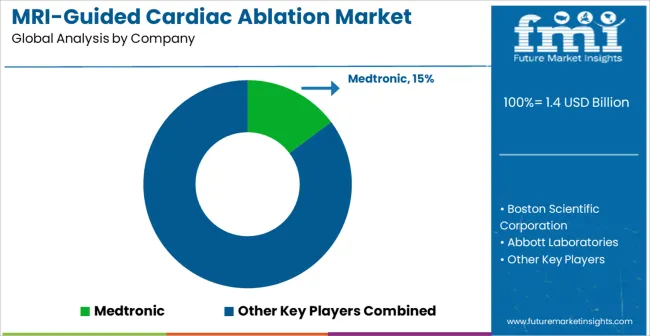
| Item | Value |
|---|---|
| Quantitative Units | USD 1.4 Billion |
| Product | MR Ablation Catheter, Stimulator System, and Others |
| End User | Hospitals and Specialty Clinics |
| Regions Covered | North America, Europe, Asia-Pacific, Latin America, Middle East & Africa |
| Country Covered | United States, Canada, Germany, France, United Kingdom, China, Japan, India, Brazil, South Africa |
| Key Companies Profiled | Medtronic, Boston Scientific Corporation, Abbott Laboratories, Johnson & Johnson, Siemens Healthineers, Koninklijke Philips N.V., Biosense Webster, St. Jude Medical, AtriCure, Stereotaxis, Imricor Medical Systems, Biotronik, and MicroPort Scientific Corporation |
The global MRI-Guided cardiac ablation market is estimated to be valued at USD 1.4 billion in 2025.
The market size for the MRI-Guided cardiac ablation market is projected to reach USD 3.1 billion by 2035.
The MRI-Guided cardiac ablation market is expected to grow at a 8.1% CAGR between 2025 and 2035.
The key product types in MRI-Guided cardiac ablation market are mr ablation catheter, stimulator system and others.
In terms of end user, hospitals segment to command 58.7% share in the MRI-Guided cardiac ablation market in 2025.






Our Research Products

The "Full Research Suite" delivers actionable market intel, deep dives on markets or technologies, so clients act faster, cut risk, and unlock growth.

The Leaderboard benchmarks and ranks top vendors, classifying them as Established Leaders, Leading Challengers, or Disruptors & Challengers.

Locates where complements amplify value and substitutes erode it, forecasting net impact by horizon

We deliver granular, decision-grade intel: market sizing, 5-year forecasts, pricing, adoption, usage, revenue, and operational KPIs—plus competitor tracking, regulation, and value chains—across 60 countries broadly.

Spot the shifts before they hit your P&L. We track inflection points, adoption curves, pricing moves, and ecosystem plays to show where demand is heading, why it is changing, and what to do next across high-growth markets and disruptive tech

Real-time reads of user behavior. We track shifting priorities, perceptions of today’s and next-gen services, and provider experience, then pace how fast tech moves from trial to adoption, blending buyer, consumer, and channel inputs with social signals (#WhySwitch, #UX).

Partner with our analyst team to build a custom report designed around your business priorities. From analysing market trends to assessing competitors or crafting bespoke datasets, we tailor insights to your needs.
Supplier Intelligence
Discovery & Profiling
Capacity & Footprint
Performance & Risk
Compliance & Governance
Commercial Readiness
Who Supplies Whom
Scorecards & Shortlists
Playbooks & Docs
Category Intelligence
Definition & Scope
Demand & Use Cases
Cost Drivers
Market Structure
Supply Chain Map
Trade & Policy
Operating Norms
Deliverables
Buyer Intelligence
Account Basics
Spend & Scope
Procurement Model
Vendor Requirements
Terms & Policies
Entry Strategy
Pain Points & Triggers
Outputs
Pricing Analysis
Benchmarks
Trends
Should-Cost
Indexation
Landed Cost
Commercial Terms
Deliverables
Brand Analysis
Positioning & Value Prop
Share & Presence
Customer Evidence
Go-to-Market
Digital & Reputation
Compliance & Trust
KPIs & Gaps
Outputs
Full Research Suite comprises of:
Market outlook & trends analysis
Interviews & case studies
Strategic recommendations
Vendor profiles & capabilities analysis
5-year forecasts
8 regions and 60+ country-level data splits
Market segment data splits
12 months of continuous data updates
DELIVERED AS:
PDF EXCEL ONLINE
Cardiac Rehabilitation Market Size and Share Forecast Outlook 2025 to 2035
Cardiac Monitoring And Cardiac Rhythm Management Devices Market Size and Share Forecast Outlook 2025 to 2035
Cardiac Rhythm Management Devices Market Size and Share Forecast Outlook 2025 to 2035
Cardiac Valvulotome Market Size and Share Forecast Outlook 2025 to 2035
Cardiac Ambulatory Monitoring Market Size and Share Forecast Outlook 2025 to 2035
Ablation Technology Market Size, Share, and Forecast Outlook 2025 to 2035
Cardiac Rhythm Remote Monitoring Devices Market Size and Share Forecast Outlook 2025 to 2035
Global Ablation Devices Market Trends - Growth, Innovations & Forecast 2025 to 2035
Cardiac Ultrasound Systems Market - Trends & Forecast 2025 to 2035
Cardiac Assist Devices Market Growth – Trends & Forecast 2025 to 2035
Cardiac Biomarker Diagnostic Test Kits Market Analysis – Trends & Forecast 2025 to 2035
Cardiac Surgery Devices Market Analysis – Trends & Forecast 2024-2034
Cardiac Rhythm Management Market Insights - Trends & Forecast 2024 to 2034
Cardiac Reader System Market Growth – Trends & Forecast 2019 to 2027
Cardiac Medical Device Market
Intracardiac Echocardiography Market Insights - Growth & Forecast 2025 to 2035
Intracardiac Imaging Market Trends – Industry Growth & Forecast 2024-2034
Laser Ablation Systems Market Size and Share Forecast Outlook 2025 to 2035
Mobile Cardiac Telemetry System Market Size and Share Forecast Outlook 2025 to 2035
Tumour Ablation Devices Market Size and Share Forecast Outlook 2025 to 2035

Thank you!
You will receive an email from our Business Development Manager. Please be sure to check your SPAM/JUNK folder too.
Chat With
MaRIA